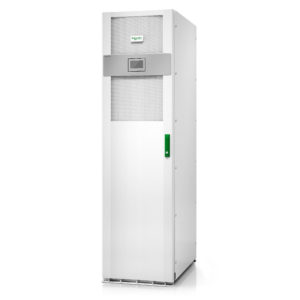 The development of high-powered lithium-ion cells and the increasing sophistication of IoT-enabled UPS offering a better return on investment and a more sustainable and resilient power protection solution for mission-critical IT and electrical environments comments Marc Garner, VP, Secure Power Division, Schneider Electric UK&I
The development of high-powered lithium-ion cells and the increasing sophistication of IoT-enabled UPS offering a better return on investment and a more sustainable and resilient power protection solution for mission-critical IT and electrical environments comments Marc Garner, VP, Secure Power Division, Schneider Electric UK&I
Valve regulated lead-acid (VRLA) batteries have been the first choice of power source in uninterruptible power supply (UPS) systems for many years. Globally they have continued to be popular for many reasons, they are relatively inexpensive to acquire, are based on mature technology and offered end-users, for a long time, what was a relatively good means of preventing downtime.
Today, however, the winds of change are upon us, and with the development of new high-powered lithium-ion (li-ion) cells, it has emerged as a front-runner for forward thinking electrical engineering and IT professionals, offering a better return on investment than legacy counterparts.
The benefits of li-Ion are many, and today are seen as a more sustainable and resilient power protection solution for end-users in mission-critical IT and electrical environments. They are a smaller size, have longer operating lives, and can withstand many more charge/recharge cycles than VRLA alternatives. The main trade off, in many respects, has been acquisition cost, which was traditionally far higher for li-ion. Now, however, with greater production volumes and increased adoption, that is fast becoming a thing of the past.
Lower TCO
There a number of reasons why electrical professionals may choose to specify lithium-ion UPS over VRLA, the main being they offer end-users a far lower total cost of ownership (TCO) when measured over the lifecycle. Studies detailed in Schneider Electric White Paper #229: ‘Battery Technology for Data Centres’, for example, found that over a 10-year period, Li-ion delivered a total cost of ownership (TCO) that is between ten percent and forty percent lower than equivalent systems using VRLA.
The chemistry within lithium-ion batteries also offers a much higher specific energy density than VRLA alternatives, with the former offering capacities between 70 and 260Wh/kg as compared with the latter’s typical range between 15 and 50Wh/kg.
Many batteries deteriorate over time and will often need to be replaced when capacity at full charge reaches between sixty and eighty percent of the rated value. For lead acid batteries this threshold is typically reached somewhere between 200 and 400 cycles, whereas a lithium-ion battery can withstand up to more than 1000 cycles.
Another factor to consider, depending on the specific chemistry employed, is that some li-ion cells can withstand more than 5,000 cycles. For this reason too, lithium-ion batteries offer a longer operating life, typically between ten and fifteen years, than VRLA which need to be replaced after four to six. Clearly, despite any increase in acquisition cost, the long-term lifecycle, energy efficiency and resiliency gains far outweigh the small cost increase that has traditionally been a deterrent in their adoption.
Size, space, place
Lithium-ion batteries can also be particularly advantageous in other circumstances, they offer a smaller footprint, specifically in terms of size and are much lighter than equivalent lead-acid alternatives and depending on the size of the application, the electrical environment and on the procurement requirements of the customers, a smaller UPS footprint can also offer major benefits to the user. Typically, a lithium-ion UPS will occupy between fifty percent and eighty percent less floor space and will weigh between sixty percent and eighty percent less than a lead acid battery. In the case of micro data centres, a small UPS helps the edge computing system to fit into areas, which weren’t typically designed to host critical IT. This includes inside offices, network closets, industrial manufacturing and 5G environments, which all require local processing and storage closer to the point of use.
In the case of larger hyperscale or colocation facilities, the competitive nature of that business means that any space saved on the power infrastructure can be more utilised for profit generating IT and white space, which increases revenue while sacrificing nothing in terms of reliability or uptime.
Proactive servicing and maintenance
 Given their longer operating life, lithium-ion batteries need to be replaced far less frequently and thus incur lower maintenance costs, which can be particularly advantageous for systems located in small or remote sites. These distributed applications have little or no onsite service personnel, but are just as mission-critical as their larger counterparts, so any means to proactively identify the realtime health and status of a UPS from any remote location becomes crucial.
Given their longer operating life, lithium-ion batteries need to be replaced far less frequently and thus incur lower maintenance costs, which can be particularly advantageous for systems located in small or remote sites. These distributed applications have little or no onsite service personnel, but are just as mission-critical as their larger counterparts, so any means to proactively identify the realtime health and status of a UPS from any remote location becomes crucial.
Here a key factor to consider is the maintenance schedule, and due to analytical capabilities built within IoT-enabled UPS, new software systems are opening doors for electrical and IT professionals to bridge the endemic skills gap; providing new services to prevent customer downtime. According to the 2017 Centrica Resilience Report, 39% of businesses experienced unscheduled downtime as a result of an energy-related failure, meaning the role of the consultant is becoming more important.
Built-in battery management systems (BMS) within li-ion UPS communicate directly with remote management software, allowing servicing partners to be alerted of any issues so that they can be rectified immediately.
Enabling sophisticated energy management
Given the growing emphasis on power efficiency in data centres, IT and electrical environments, for both financial and environmental reasons, the energy stored in li-ion batteries can also be put to effective use as revenue-generating assets, rather than a standby solution to guard against mains disruption.
If electricity is charged at peak rates at some times of the day, and at a much lower rate at others, then operators can practice load shifting, essentially making sure that batteries are fully charged during low-tariff periods and then using that stored energy, rather than mains power, to supply the load when the tariff is high.
For tariffs in which operators are penalised if the overall power drawn from the mains exceeds an agreed limit over a period of time, the technique of peak shaving ensures that battery power is used temporarily to drive the load so that the limit is not breached.
At a more sophisticated level, microgrids also allow organisations to share their energy resources, including those stored in UPS batteries, in a controlled and efficient manner with utility providers. Microgrids can also enable data centres to sell their stored energy back to the grid where it can be deployed to other customers, and given their ability to withstand many charge/discharge cycles, lithium-ion batteries are particularly suited to supporting these technologies.
Although still incurring a capital expenditure premium compared with older alternatives, lithium-ion batteries offer many great benefits to electrical specifiers, data centre and IT consultants due to their energy efficiency, compact size and flexibility of operation.
For more information on the EcoStruxure Specifier Tool, click here.



